Top Iranian Handicrafts You Should Know
Iran is regarded as one of the most civilized nations in the world due to its long history; as a result, it has the richest culture and way of life.
Today, Iran has been able to capture the attention of the world. This civilization is, without a doubt, responsible for the development of many arts up to the present, allowing Iran to rank among the top nations in many artistic fields like pottery, calligraphy, weaving, and painting.
In this post, we introduce the top most magnificent Iran handicrafts, which bring a manifestation of ethnic and national culture to the field of emergence and have a worldwide reputation.
In general, handicrafts can be considered "the use of art by the hands of people using basic tools and local materials, which produce an artistic industry."
The distinctions between handicrafts and contemporary goods are innumerable. These handicrafts differ from other items in terms of how they are made, but they also encourage a distinct mindset in individuals who are interested in this skill.
With its rich cultural heritage and extensive historical background, Iran has played a key role in the development of local handicrafts over the centuries and into the present, resulting in 3000 various types of Iran handicrafts being recognized all around the world.
Top Iranian Handicrafts
- Persian Carpet
- Persian Miniature Painting
- Persian Mina Kari (Enamel)
- Persian Firoozeh Koobi (Turquoise Inlaying)
- Glass Enamel
- Persian Ghalamkar (Textile Painting)
- Persian Khatamkari
- Persian Monabat (Wood Carving)
- Persian Toreutics (Ghalamzani)
- Persian Direct Heat Glassblowing
- Persian Jajim
- Persian Kilim
- Persian Ziloo Weaving
- Persian Glazed Pottery
- Persian Filigree (Noghre-Kari)
- Persian Pateh Doozi
- Persian Namadmali (Felt Making)
- Persian Mat Weaving (Hasir Bafi)
- Persian Saddlery (Charm-Doozi) and Leather Carving
- Persian Khamak Sewing (Khame-Doozi)
1. Persian Carpet
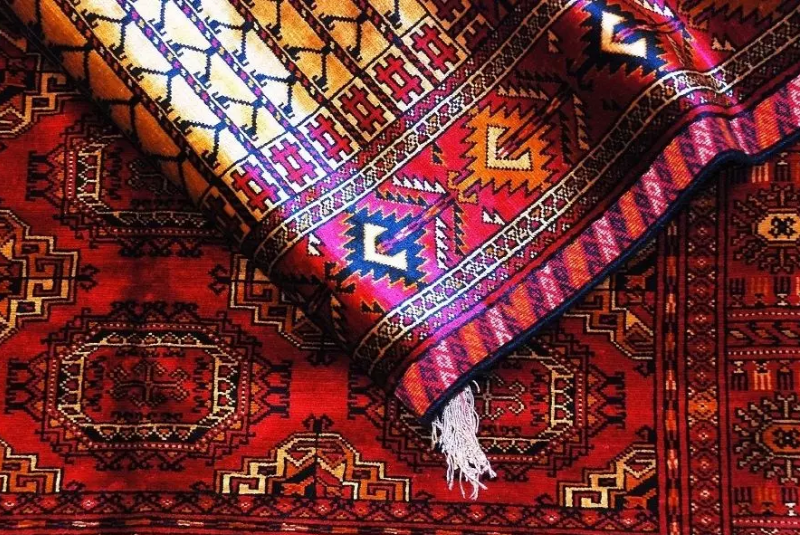
Carpets are the most well-known form of Iran handicrafts and Persian art in the West. First encounters with Persian carpets among Europeans date to at least the 15th century, and the first notion that Iran is unsurpassed in carpet making hasn't altered. No one knows with certainty when carpet weaving in Iran first began. The earliest Iranian carpet that has been discovered dates to around 500 B.C. It is now known as Pazyryk after the Siberian archaeological location where Scythian leaders' frozen tombs were excavated.
Iranian carpets' patterns have a significant role in determining their worth. Professional weavers often create a paper model of one-fourth of a carpet's surface before beginning the weaving process; nomads typically improvise. The carpet is made up of the main area and the margins, which may be further broken down into three portions.
Iranian carpets have an astounding array of designs. Their intricate design and attention to detail reveal a lyrical view of the world and a faith in the power of symbols. The garden is one of the most significant subjects on which a Persian carpet designer focuses. According to some historians, among the magnificent loot taken by the Muslim Arabs when they seized the Persian capital "Ctesiphon" in 637 was a vast carpet depicting a traditional Persian garden that was built for the audience hall of the king's palace and represented the notion of Paradise.
Iranian cities like Qom, Isfahan, Tabriz, Kerman, Yazd, Kashan, and nomadic areas like Baktiari and Qashqai are the main hubs for carpet weaving at the moment.
The quality of the wool is one of the most crucial elements in determining a rug's durability and aesthetic appeal. Iranian carpets have historically been the most sought-after rugs in the world and one of the famous things to buy in Iran as the country produces the greatest carpet wools anywhere in the world.
| Also might be interesting: Persian Art & Everything About It!
2. Persian Miniature Painting
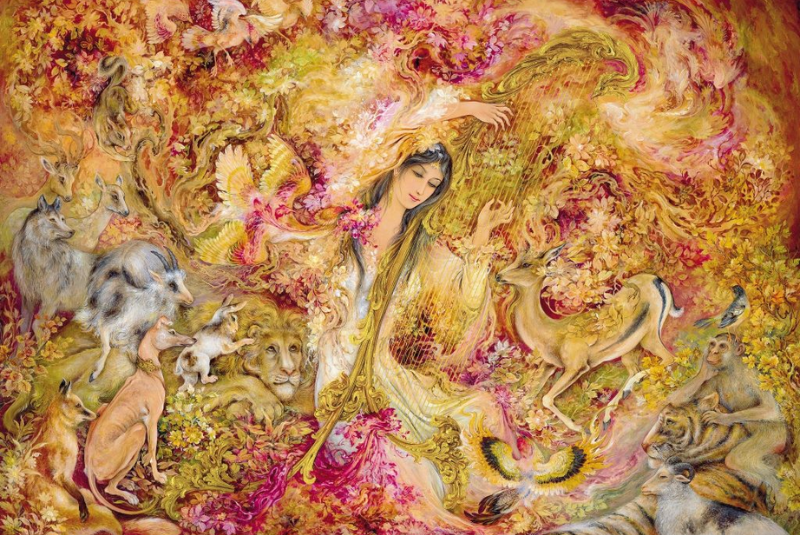
A Persian miniature is a tiny painting on a scrap of paper, a book illustration, a piece of camel bone, or any form of art that is meant to be stored in a collection of miniatures called a Murraqa. The methods used are mostly akin to the Western and Byzantine traditions of illuminated manuscript miniatures.
Iranian handicrafts painted in miniature style, such as jewelry boxes, are other types of traditional products in Iran.
Although Persian wall painting is a similarly well-established tradition, miniatures have a higher survival rate and state of preservation. Additionally, miniatures are by far the most well-known Persian painting style in the West, with many of the most significant examples being in Western or Turkish museums.
Following the Mongol conquests (1219), miniature painting gained Chinese influence and became an important Persian genre by the 13th century. The tradition's apex was attained in the 15th and 16th centuries. After this, the tradition persisted with considerable Western influence and has several current adherents.
Other Islamic miniature traditions, particularly the Ottoman miniature in Turkey and the Mughal miniature on the Indian subcontinent were heavily influenced by the Persian miniature.
3. Persian Mina Kari (Enamel)
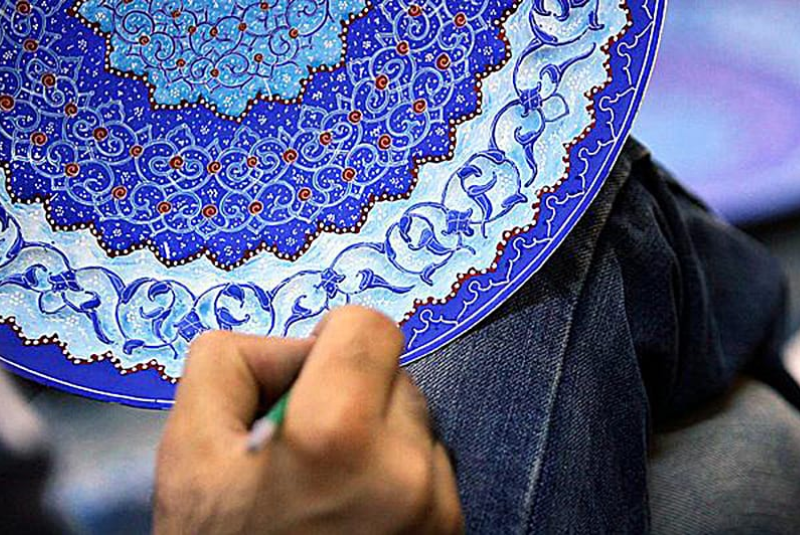
With the application of mina glaze, the technique of enameling, also known as minakari, is utilized to decorate metal and tile. Depending on the preferences of the artist, conventional patterns are employed for enamel works. Enameling is mostly done on copper and silver in Iran. One of the Iran handicrafts and Isfahan's renowned art forms is enamel work, which involves coating metal with vibrant, baked paint.
Shokrollah Sanizadeh, whose ancestor was a renowned painter, is the greatest maestro of Isfahan's enameling. In 2008–2009, one of this master's priceless creations was utilized to produce a stamp honoring Iranian handicrafts, which was then recognized as a national treasure. These painters display their paintings near Naqsh-e Jahan Square and on Chahar-Bagh Street.
4. Persian Firoozeh Koobi (Turquoise Inlaying)
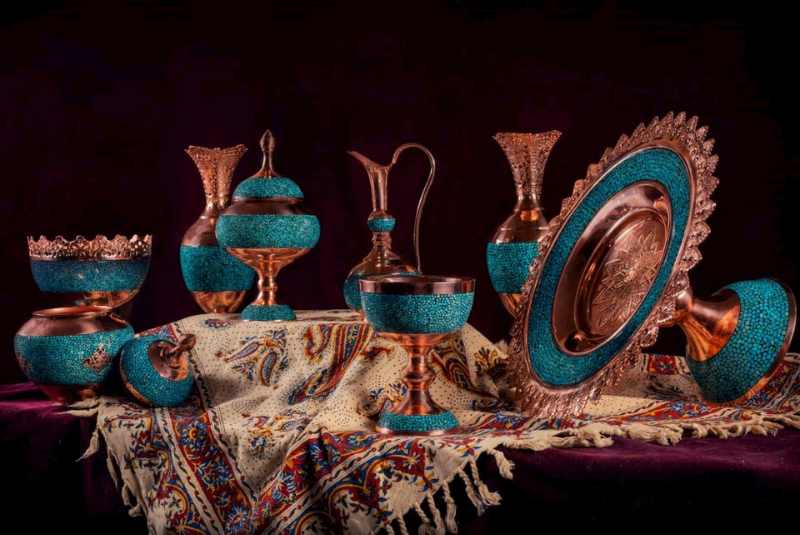
Another type of Iran handicraft known as Firoozeh Koobi is created by selecting embedding and polishing tiny bits of turquoise stone (Firoozeh) in a mosaic pattern on the surface of plates, decorations, and ornamental items with bases made of copper, brass, and silver, or bronze.
Due to its distinctive color, turquoise has been treasured as a gemstone and decorative stone for thousands of years. The history of the Firoozeh Koobi is quite recent, dating back only around 70 years. Isfahan is where these sorts of handicrafts are made.
5. Glass Enamel
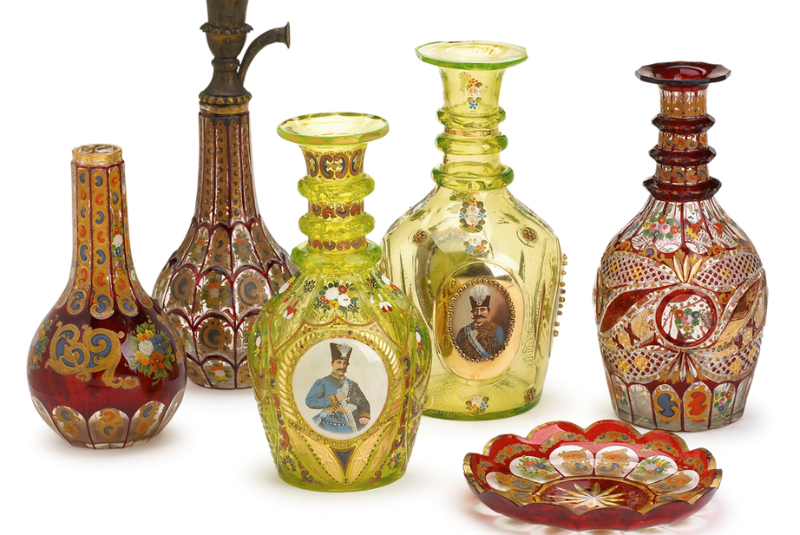
Enameled glass is decorated with various glass items and containers using the skills of color and painting.
Various museums in Iran and throughout the world house numerous, diverse examples of the enamel work on glass that has long been a favorite among various cultures. Sometimes the glass will have patterns or perhaps just a few colorful lines painted in enamel.
Additionally, this artwork is occasionally put on glass containers' bodies to transform them into objects that are stunning and remarkable.
With its delicate and attractive paintings, enameling, for instance, has transformed the craft of decorating glass bottles, glasses, glass containers, as well as mirrors into a work of art that may have a pleasing and eye-catching effect.
6. Persian Ghalamkar (Textile Painting)

One of the most famous Iran handicrafts is Ghalamkar, a kind of textile printing that makes use of patterned wooden stamps. Pear wood, which has high flexibility and solidity for carving and lasts longer, is the primary material used to make the stamps. There are hundreds of distinct patterns in each Ghalamkar studio, including arabesques, flora and fauna, geometrics, pre-Islamic motifs, hunting scenes, polo matches, and Persian poetry. Fixing their designs, the cloth is first steamed for at least an hour after printing is complete. It is then brought to the riverbank and maintained in a few basins so that it can soak thoroughly. The pieces should then be soaked and boiled with a particular color stabilizer before being washed in the river once more as the last stage. Isfahan is one of the most important creators and producers of this kind of art in the world.
7. Persian Khatamkari

The practice of Khatam Kari involves adorning wooden surfaces with tiny triangle-shaped veneers that resemble little mosaics and are manufactured from a variety of woods and materials. Among these materials are areca wood, ebony, citron tree wood, jujube wood, and camel, horse, and cow bones.
Although the oldest known piece of Khatam-Kari art dates to the Safavid era, the actual beginning of the art is unknown.
During the Safavid era, Isfahan City served as the primary hub for Khatam production; however, Shiraz eventually overtook it. It is employed to make Iran handicrafts such as miniature boxes, frames, chessboards, backgammon boards, and Quran racks.
8. Persian Monabat (Wood Carving)

A branch of the woodworking profession and one of the best Iran handicrafts, known as Monabat-Kari, is regarded as an artistic method. It includes carving on wood, and the person who carves on the wood is known as a woodcarver. This is a traditional Persian skill from ancient people who learned to use sharp tools and began to carve wood. Iranian cities like Golpayegan, Esfahan, Shiraz, Abade, Malayer, and Shahrod are currently the pioneers in this art, which is being practiced widely throughout the country.
Wood is the primary component of Monabat-Kari, and the more compact its texture, the better and more durable the Monabat craft. The greatest types of wood for making Monabat crafts are walnut, beech, plane, and pear.
The delicate art of carving is used to decorate wooden boxes, wooden photo frames, mirror frames, sofa and chair handles, tables and door and window arches, etc.
9. Persian Toreutics (Ghalamzani)
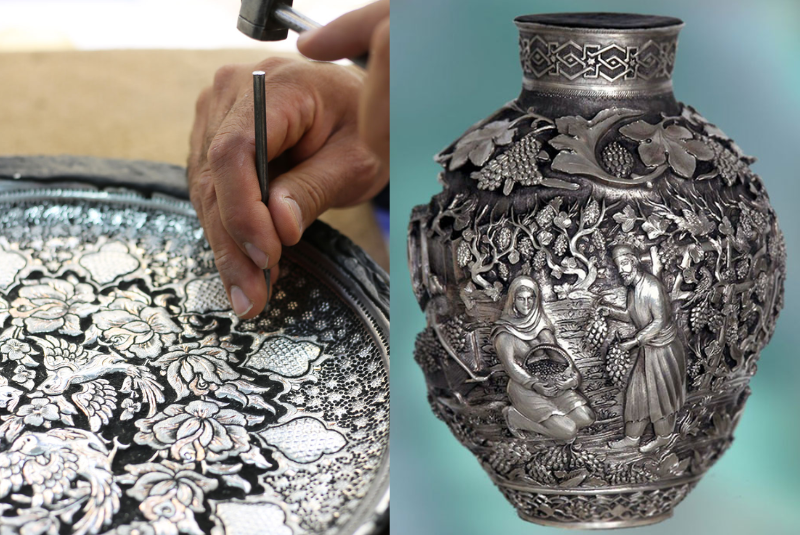
Toreutics (Ghalamzani) is the art of using burins to hammer or engrave metal objects with magnificent and intricate engravings and patterns.
In Iran, toreutics is regarded as a type of artistic metalworking and craftsmanship. Its origins are unclear, although some archaeologists and art historians think they may be traced to the pre-Achaemenid period when nomadic Iranians known as the Scythians or Sakas lived.
There is proof that the art's roots may be found in mountain carving, the construction of royal palaces and historical monuments, and even in the time of the cavemen. From there, the craft evolved into engraving and eventually toreutics.
The most common metal used in this kind of creative Iran handicraft is copper, which is soft and flexible. According to another viewpoint, there are two primary styles of Persian Toreutics: the Isfahan Style and the Tabriz Style. The Isfahan Style involves pounding, whereas the Tabriz Style uses wrist motion and pressure. Toreutics patterns in Tabriz are flatter, but patterns in Isfahan are engraved deeper.
10. Persian Direct Heat Glassblowing
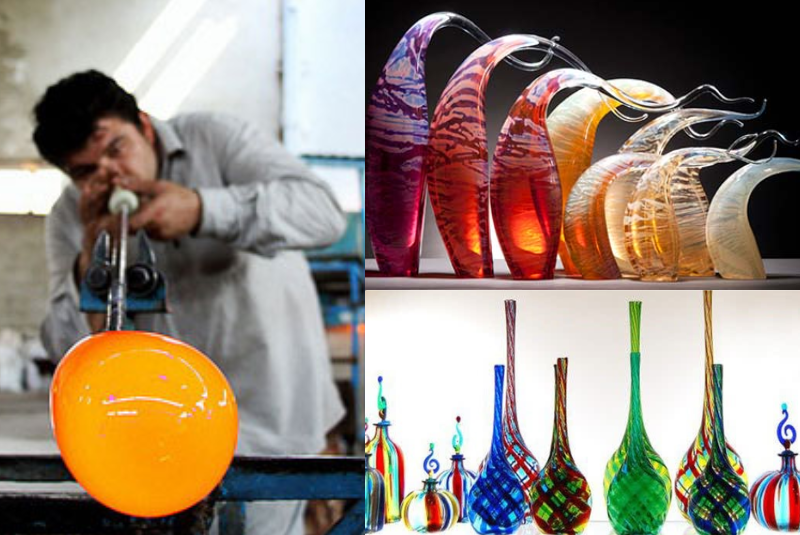
In Glassblowing in Iran, the glassblower mixes raw glass materials such as silica, borax, carbonate, lime, scale, etc. Then the mixture is made into a powder and melted in a glass furnace at a temperature of about 1400 degrees Celsius. As a result of the heat of the molten glass material, it turns into a liquid and is ready to work. Then, by means of the "blowpipe," he takes some molten material from the furnace valve and by blowing into it, it becomes a bubble, which is called "swan" in glassmaking. He takes the swan into the oven again and blows it. Finally, the glassblower shapes it with pliers and other tools and transfers it to the greenhouse to be ready for packaging after cooling.
This method, which came from Turkey and spread in Iran, especially in East and West Azerbaijan, started with the making of casting parts of chandeliers and then was used to make small glass sculptures.
11. Persian Jajim
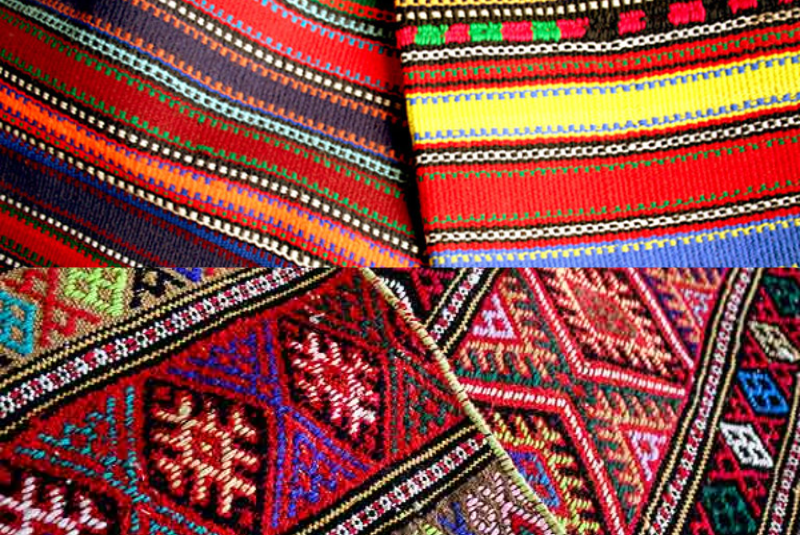
As one of the best Iran handicrafts, Jajim is a type of handmade flat-woven textile made of natural-colored and delicate woolen or cotton threads.
Wool-made Jajim absorbs perspiration from the body. It is advantageous to use it as a blanket in the Sardsir region for rheumatoid arthritis sufferers. Additionally, Jajim, made of cotton, can be worn in Iran's tropical regions to keep the body cool.
In addition to being used as a bed, carpet, and underlay, Jajim is also used to carry and move goods and furniture.
In Iran, the massive production of Jajim belongs to the nomads of Ardabil province.
12. Persian Kilim
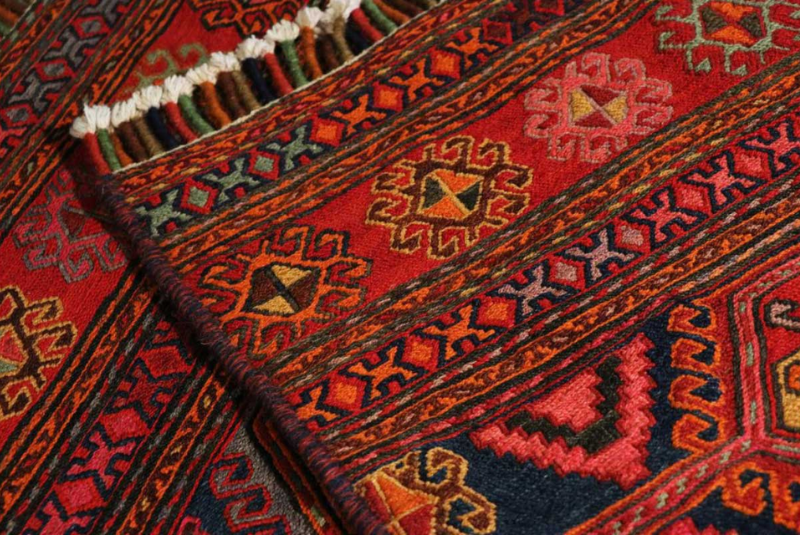
Kilims are smooth-textured kind of carpets that can be described as pile-free. The carpets are woven using a variety of threads: wool, cotton, silk, and other fluffy materials.
Since Kilims are a sort of nomadic hand-woven fabric, they feature basic, abstract designs that are frequently influenced by their surroundings and the natural world, and they are a representation of the authentic nomadic way of life.
Natural motifs like the sun and plant motifs like trees and flowers, with the cedar tree having a special place in the Kilim weaver's heart because of its everlasting greenness, among other motifs. When weaving Kilims, the carpet weaver employs horizontal, vertical, and diagonal lines as well as extremely basic geometric designs.
13. Persian Ziloo Weaving

One of the oldest Iran handicrafts and hand-woven items is called Ziloo, and it is utilized as a cheap carpet made of summer-cooling yarn. Ziloo weaving originated in Yazd province at a place named Beshnighan near Meybod, and from there it expanded to other locations. Ziloo weaving is said to be the developed product of mat weaving, and its weavers were motivated by this profession because of how much Ziloo resembles mats in design and texture.
Ziloo is shielded from the desert sands because of its cotton weave, while multicolored woolen carpets will not be able to endure the sandstorm. Ziloo weaving does not affect the health of the weaver or the consumer because cotton is used as the main component with no lint in the weave, in contrast to carpet weaving, which uses wool and can result in respiratory illnesses.
Ziloo does not come in a wide range of colors as many carpets and underlays do. Ziloos for homes are typically more colorfully varied than those for mosques and are woven in blue, white, green, orange, blue, and flowery hues.
14. Persian Glazed Pottery
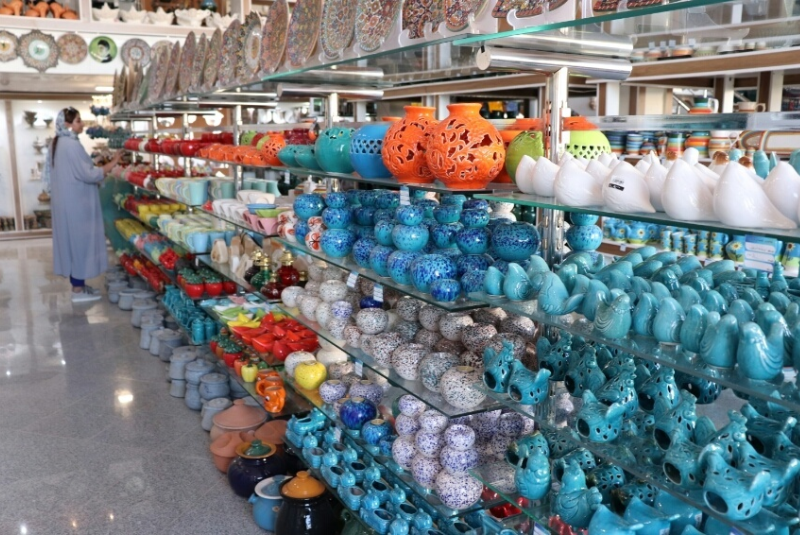
In the branch of Iran handicrafts known as "glazed pottery," clay or other mixed muds are formed by hand, on a pottery wheel, or by slushing, and then baked at 800°C after drying. The finished pottery is then glazed and re-baked at temperatures between 900°C and 1100°C to give it a glossy, permanent glaze.
One of the most distinctive patterns in handicrafts is the turquoise blue glaze used on Shahrezai ceramics from Isfahan. The pottery of this city features unique floral and fowl designs that are unmatched in the world. One of the greatest authentic handicrafts of Isfahan is pottery, which is made with excellent designs and patterns and covered in high-quality glazes.
Yazd is one of the cities that sells pottery to the Iranian ceramic market with images of the sun, fish, and chickens, which stand in for the local birdlife. Semnan pottery exhibits elegance and beauty. The greatest handicrafts in this place are jars and clay sculptures of various birds and natural patterns created by professional craftspeople. Iranian pottery has a long history, and Saveh ceramic jars with distinctive patterns and distinctive hues are well recognized.
Laljin is where the best Iranian pottery is produced. Vases and sculptures made of Laljin ceramics come in thin and golden styles. Comparing Laljin handicrafts with semi-embossed designs to other ceramics, it is easy to see that they are of higher quality, and the color and glazes remain consistent over time.
15. Persian Filigree (Noghre-Kari)
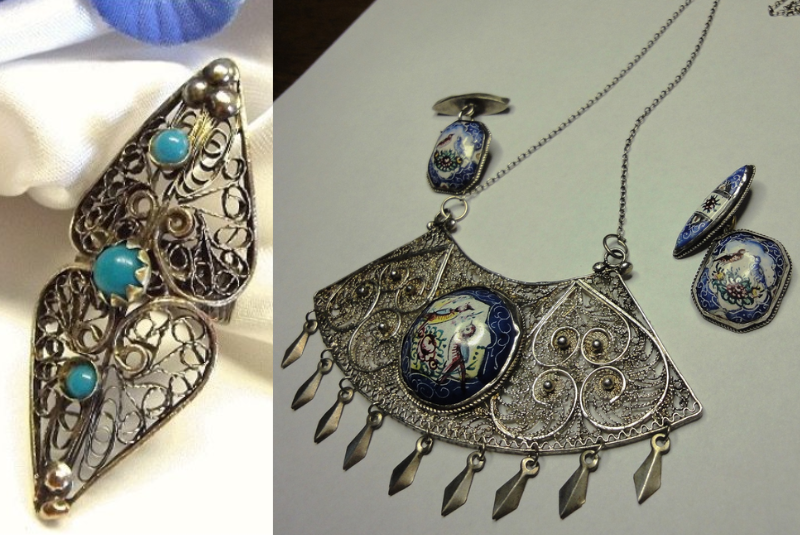
Intricate metalwork, known as filigree ( Noghre-Kari), is one of the quite common Iran handicrafts in Zanjan and Isfahan. In jewelry, it is often a decorative work made of thin wire in gold, silver, or copper that is applied mostly to gold and silver surfaces. It may also be composed of small beads, twisted threads, or both, and it may be soldered to the surface of an object made of the same metal. Isfahan and Zanjan silversmiths produce and sell sets of necklaces, earrings, bracelets and pins in this prosperous market. Paisley, Rizeh Jeqe, Barg-e Farang, leaf, bosom, ivy, double ivy, triple spring, etc., are examples of common themes. Silver-plated jewelry is one of the best souvenirs for your loved ones.
16. Persian Pateh Doozi

One of Iran's most exquisite and ancient traditional needleworks, Pateh Doozi has a rich history rooted in Kerman's ancient cultural heritage. Pateh Doozi fabric has a unique elegance and beauty that is enhanced by the delicate needlework that covers it.
Pateh Doozi artists use colorful cotton stitches on a background of thick or broad woolen cloth to weave mental pictures that are a blend of their own ideas and perceptions.
Because embroidered patterns are often neither hectic nor geometric, dark hues are employed for more creative designs instead of bright ones. Dark colors also help the motifs' connections to be more regular and attractive. Of course, vibrant colors have made their way into needlework in recent years.
The Pateh Doozi covering for Shah Nematullah Wali's tomb in Mahan, Kerman, which is regarded as one of the most exquisite and delicate instances of Pateh Doozi, is one of the earliest examples of Pateh Doozi ever discovered. Pateh Doozi can be done on table decorations, carpets and mats, curtains, pillows, coasters, Quran covers, and shawls as a few examples of unique Iranian handicrafts.
17. Persian Namadmali (Felt Making)

Felt is essentially a classic sort of Iran handicraft made from wool and is regarded as a kind of underlay. It takes a lot of time and effort to master this very old form of art.
The interesting thing about felt (Namadmali Carpet) is that, unlike all carpets and textiles, it isn't woven to prepare it. Instead, by producing pressure, humidity, and heat, wool strands become tangled and produce felt as a result.
In order to make patterned felt, craftsmen first arrange colored wool on a cloth in the desired pattern. They lay down the Karbas cloth and wrap it over the entire area. It is covered with boiling water and continuously moistened until, after several hours of Namadmali, felt is produced.
The regions of Kermanshah, Mazandaran, Khorasan, Semnan, Chaharmahal, and Bakhtiari are among the most well-known for their mastery of Namadmali art. Products made of felt include underlays, caps, jackets, and vests.
18. Persian Mat Weaving (Hasir Bafi)
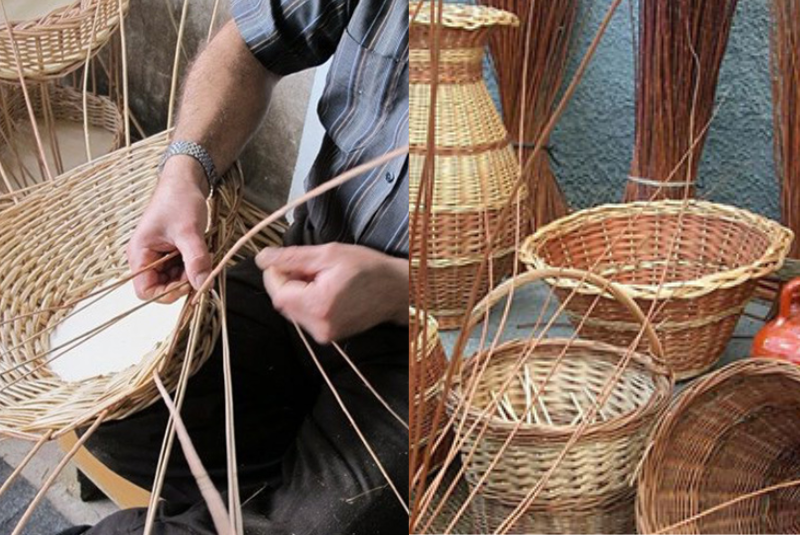
Mat weaving crafts are the most popular Iran handicrafts among both Iranians and tourists. Mat weaving is the process of making products like underlays, wicker tablecloths, baskets, plates, etc., by weaving plant-based threads by hand or with basic weaving tools.
Fibers for mat weaving are prepared in Iran's southern regions using palm leaves, leaves from a few wild palms, and stems from swamp reeds that grow in tropical areas. In northern cities of Iran, Kloosh (rice stalks) and marsh reed stalks are used for mat weaving.
19. Persian Saddlery (Charm-Doozi) and Leather Carving
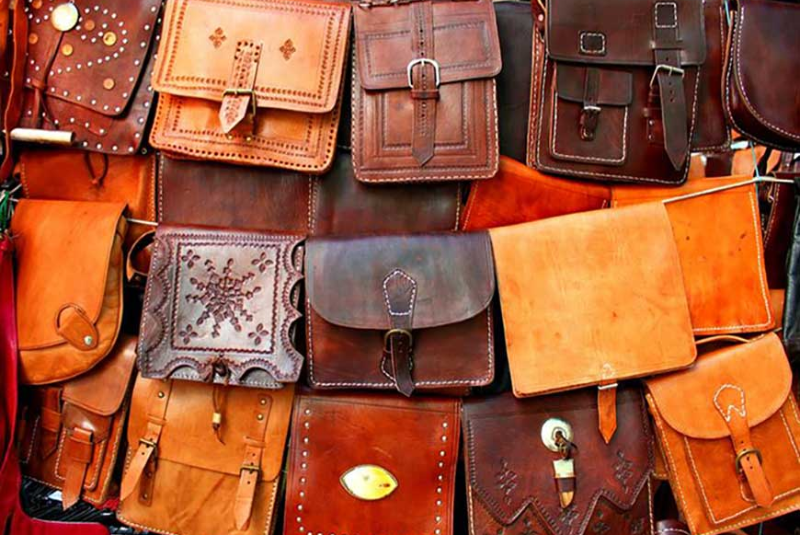
Saddlery (Saaji) is one of the oldest and most authentic traditional Iranian handicrafts and arts in Khorram-Abad and Borujerd. The term saddlery (handmade leatherwork) refers to the traditional craft of cutting and stitching leather to make products such as men's and women's handbags, gun covers, luggage, horse and mule harnesses, and other Persian accessories, including mobile phone covers and belts.
In the past, leather carving was used to adorn the book cover. Dark-colored leather is used in this kind of art, and heated metal molds are used to imprint designs onto the leather. Currently, leather products with delicate engraving designs have a much higher value than the normal type without design, and the reason for this is the unique beauty of leather carving art.
20. Persian Khamak Sewing (Khame-Doozi)

Khame-Doozi is a style of traditional Iranian marquetry and embroidery art that is made from unique and original Sistan and Baluchistan native patterns and is sewed with fine silk fibers in a conspicuous shape, mainly on linen textiles. As one of the artistic Iranian handicrafts, Khamak Sewing is made up of unique and real indigenous themes, such as geometric reliefs and flowers with eight points, rhombic, square, triangular, and cross shapes.
Bottom Line
Iran handicrafts are popular at traditional marketplaces around the country. Any nation's handicrafts may indeed be viewed as a window into its people's civilization and culture. As one of the first forms of communication between people in various nations, handicrafts are a valuable source of historical data for several cultures throughout the globe.
In this article, we introduced the best of Iran handicrafts. On your next trip to Iran and sightseeing in the ancient and beautiful cities of this country, don't forget to buy Iranian handicrafts as souvenirs.


Comment
Leave a Comment